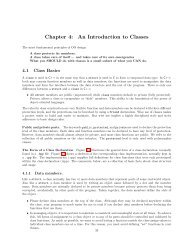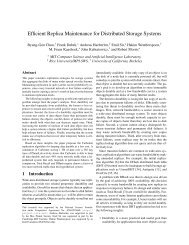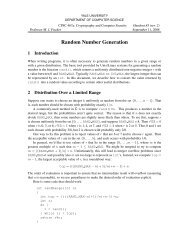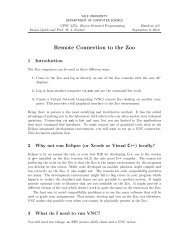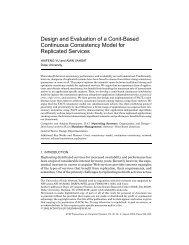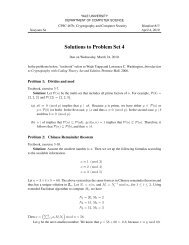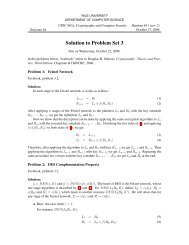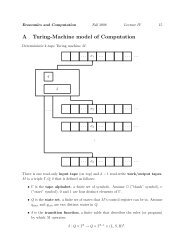Unreliable Failure Detectors for Reliable Distributed Systems
Unreliable Failure Detectors for Reliable Distributed Systems
Unreliable Failure Detectors for Reliable Distributed Systems
You also want an ePaper? Increase the reach of your titles
YUMPU automatically turns print PDFs into web optimized ePapers that Google loves.
248 T. D. CHANDRAAND S. TOUEGIn R~ all processes in 110 propose O and all processes in 111 propose 1. Noprocess crashes in F~, that is, Vt E 9: F~ (t ) = 0. All messages from processesin 110to those in 111and vice-versa, are delayed until time max(ro, t ~). Until timemax(to, t ~), every process in II. suspects every process in ill, and every processin 111 suspects every process in IIo. After time max(ro, t ~), no process suspectsany other process. More precisely:Vt Smax(rO, t,):Vp E rIo:HA(p,t) = rI~Vp G rI,:z-l~(p, t) = 1-1oVf > max(tO, tl), Vp G II: H~(p, t) = 0.Note that HA E $?b(FA) as required.Until time max(ro, tl), R~ is indistinguishable from I?. <strong>for</strong> processes in Ho, and R~is indistinguishable from R ~<strong>for</strong> processes in 111.Thus, in R~, q. decides O at time to,while q, decides 1 at time t~.This violates the agreement property of Consensus. ❑In the appendix, we refine the result of Theorem 6.3.1: We first define aninfinite hierarchy of failure detector classes ordered by the maximum number ofmistakes that failure detectors can make, and then we show exactly where in thishierarchy the majority requirement becomes necessary <strong>for</strong> solving Consensus(this hierarchy contains all the eight failure detector classes defined in Figure 1).7. On Atomic BroadcastWe now consider Atomic Broadcast, another fundamental problem in faulttolerant distributed computing, and show that our results on Consensus alsoapply to Atomic Broadcast. In<strong>for</strong>mally, Atomic Broadcast requires that allcorrect processes deliver the same messages in the same order. Formally, AtomicBroadcast is a <strong>Reliable</strong> Broadcast that satisfies:Total order. If two correct processes p and q deliver two messages m and m‘,then p delivers m be<strong>for</strong>e m‘ if and only if q delivers m be<strong>for</strong>e m‘.The total order and agreement properties of Atomic Broadcast ensure that allcorrect processes deliver the same sequence of messages. Atomic Broadcast is apowerful communication paradigm <strong>for</strong> fault-tolerant distributed computing.18We now show that Consensus and Atomic Broadcast are equivalent in asynchronoussystems with crash failures. This is shown by reducing each to theother.19 In other words, a solution <strong>for</strong> one automatically yields a solution <strong>for</strong> theother. Both reductions apply to any asynchronous system (in particular, they donot require the assumption of a failure detector). This equivalence has importantconsequences regarding the solvability of Atomic Broadcast in asynchronoussystems:MFor ~xample, see Chang and Mmemchuk [1984], Cristian et al. [1985/1989], Birmmtand Joseph[1987], Pittelli and Garcia-Molina [1989], Budhiraja et al. [1990], Gopal et al. [1990], and Schneider[1990].19They are actually quiva]ent even in asynchronous systems with arbitrary failures. However, thereduction is more complex and is omitted here.



